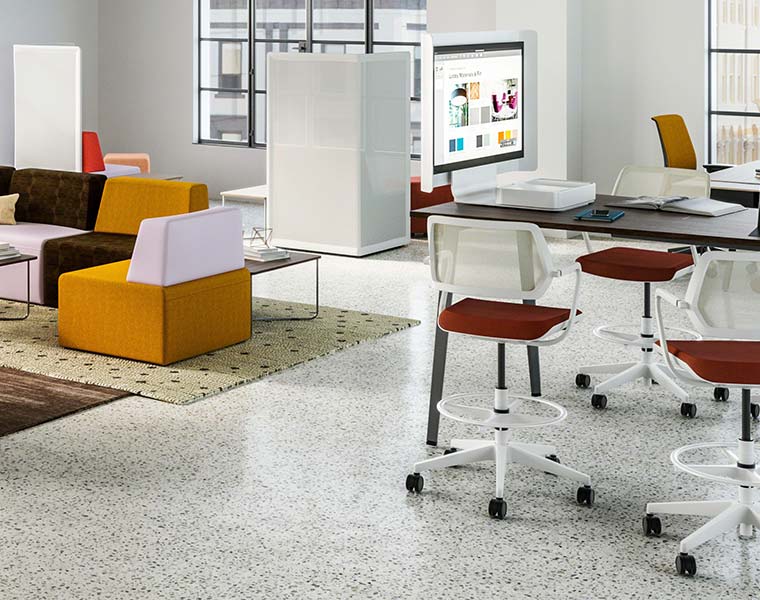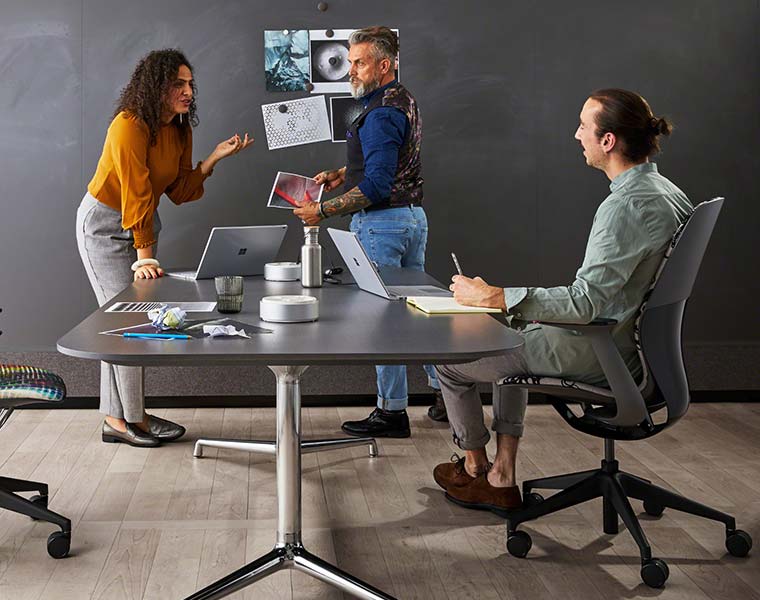According to the World Economic Forum, Artificial Intelligence (AI) machines handled nearly 30% of tasks across 12 industries during 2018. Whether you’re excited or terrified by it, it’s an undeniable fact that AI is on the verge of transforming the modern workplace beyond recognition. So, what does this mean for office fit out and design?
Remember a time when we didn’t have smartphones, voice control or sensors which control the lights when you walk into a room… Those times aren’t all that long ago and just think about how much has changed since then.
Since the many developments in modern technology, consider how much your professional life has evolved and how differently you tackle your to-do list on a daily basis. It’s only a matter of time before the physical working environment and working cultures look entirely different again as AI becomes more, well, intelligent.
What is Artificial Intelligence?
Being described as the ‘Fourth Industrial Revolution’, Artificial Intelligence is basically the development of interfaces and computer systems which can perform tasks that previously required human intervention. This includes things like visual perception, language translation and speech recognition.
AI generally covers three main areas:
Machine Learning – adapting technology and software so that it can operate without humans.
Automation – robotic programming to make the repetition of high-volume tasks automated.
Natural Language Process – the intelligent identification of the human language.
The benefits of Artificial Intelligence in the workplace
AI makes data gathering and the delivery of services of a whole new ball game which has the following advantages:
- Using chatbots to improve customer service and speed of response – something companies like Google have already seen significantly improve profitability.
- Removing human emotion and bias from HR procedures.
- Fighting cybercrime and improving elements of cyber security as trends and anomalies are more easily identified.
- Making processes and systems more efficient, which frees up human time.
- Using complex and meticulous systems to reduce human error.
- Helping future-proof your workplace for ongoing evolution and improvement.
- Attraction and retention of the best new talent in your industry.
With these promising benefits on offer, it’s no surprise that so many businesses are looking to implement AI going forward.
What does this all mean for office design and furniture?
There’s no doubting that AI is going to transform the working world as we know it – workplaces will become more multi-sensory environments and revolutionise employee experience. The ‘smart office’ which was once so new-fangled and ahead of the curve will become the norm as we make way for new attitudes, behaviours and the products needed to facilitate them.
For example:
Evolution of wellbeing and ergonomics
One of the biggest ways AI is changing the workplace is how users can move around the space, taking agile working to the next level.
AI powered interfaces enables the creation of augmented spaces, which mean digital displays no longer have to be tethered or mounted to walls, stands or even computer screens. Displays can be shown as 3D information suspended in the air, negating the need for a million different tabs and multiple screens. Users can then interact with this immersive information by physically turning around in the space – perhaps even in a 360-degree circle.
This improves teamwork in the hyper-collaborative era but also further addresses the issue of physical health and freedom of movement around the space. Being able to make larger, freer movements which require more time spent not seated promotes improved blood flow, muscle retention and musculoskeletal health.
Steelcase’s new Flex collection (pictured below) is already an example of how product design and commercial furniture is adapting to this increased range of movement. Read more about Flex in our recent blog post about portable office furniture and how the modern workplace is on the move.
As well as matters of physical health and movement, AI is also expected to have a positive impact on mental wellbeing. Sensors which use biosensory technology detect mood and energy levels, for example, to identify low motivation, low productivity and stress. Much like the smartwatches many of us wear today, smart sensors can also monitor activity levels to encourage more movement during the day and therefore, better mental health.
Technology becomes your co-worker
Another way in which AI is shifting the status quo is by becoming a colleague or co-worker. What we mean by this are the ways in which new interfaces, systems and software can swoop in to help you improve how you tackle your job. In this way, AI has the potential to become a mentor and something you can rely on to assist you in your role, whatever that may be.
Some examples:
- Translation software which will improve video conferencing facilities and help users better communicate around the world.
- Using human data analysis to help evaluation and development of processes.
- Further support for different learning styles i.e. digital and analogue creativity.
- Gathering email and calendar information to gain insight into workload and management.
- Improved speech and voice recognition will help to improve communication between remote and resident workers.
The PwC Consumer Intelligence Series found that:
- 50% would follow an AI system if it was able to predict the most efficient way to manage a project.
- 65% would free employees from menial day-to-day tasks if an AI system was there to take over.
The problem(s) with AI
For many AI is a terrifying prospect – that we will eventually become so easily replaced in our job roles by machines – and understandably too. The solution for this is to position AI as complimentary rather than a replacement. However, nearly 65% of PwC’s respondents would be opening to offering employees new opportunities if AI was able to free up some of their time.
Other issues include confidence with new technology, the training that will be required, the obvious financial investment and issues around privacy which will come as a result of more invasive data insights and human analysis. That said, Artificial Intelligence is still very much in its infancy so no doubt, over the coming years, solutions to any problems presented will be put in place.









